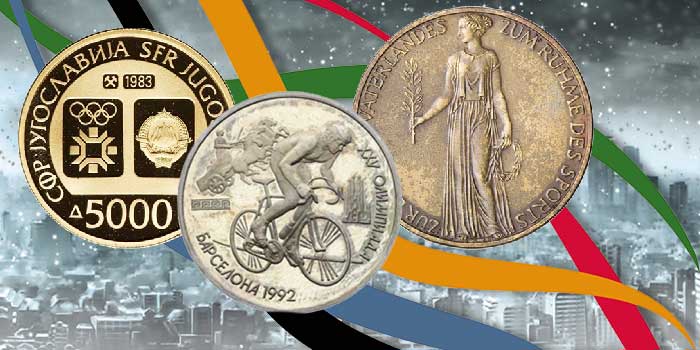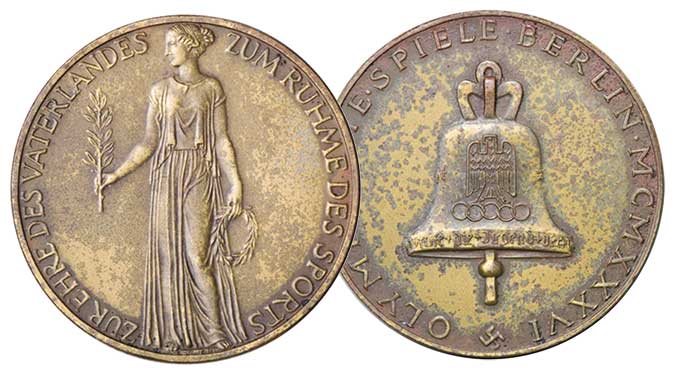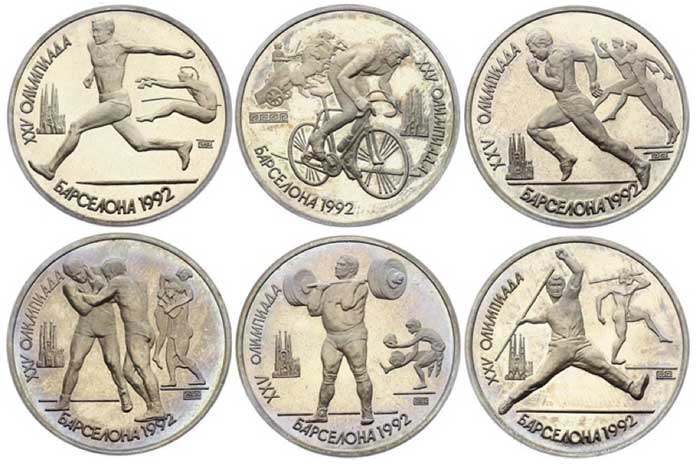
By Tyler Rossi for CoinWeek …..
While watching the opening ceremony to the Olympic Games, one is easily overwhelmed by the pomp and circumstance.
Costing hundreds of millions if not billions of dollars to host, the Games represent a massive financial commitment by the host city and country. As such, they tend to be propagandized and memorialized – perhaps none more so than the 1936 Games hosted by Germany in Berlin. The Games served as propaganda for the Third Reich in order to project a vision of not only Germany’s economic recovery from the devastations of World War I and the Great Depression but also the self-declared superiority of the “Aryan” race and culture.
And like most Olympic hosts, Germany minted an official commemorative coin (Figure 1).
While the 1936 Games occasioned the striking of a handsome coin in line with contemporary styles, the same can also be said for the 2014 Olympics. Russia produced a massive bullion coin with a very busy design to showcase the XXII Olympic Winter Games and the XI Paralympic Winter Games of 2014 in the resort city of Sochi. This monstrosity, depicting historical winter activities, measures 100 mm and weighs just over a kilogram of .925 silver.


However different the style and artistic quality, these coins (and others like them) serve as lasting memorials to the fleeting spectacle of the Olympic Games.
The Soviet Union and the 1992 Games
Ideally a platform for unity and solidarity between nations, the Olympic Games have not changed significantly over the past century. That being said, it’s fascinating to look back at previous Games as snapshots in time–snapshots that sometimes include states that no longer exist. As the “Iron Curtain” fell and authoritarian states across Eastern Europe began their messy transitions to democracy, this became a more commonplace occurrence.
Since planning and organizing these massive events takes years, official commemorative coins are often struck well in advance of the opening ceremonies. This can lead to interesting numismatic situations, as demonstrated by the Soviet commemorative coins leading up to the 1992 Barcelona Summer Olympics. Despite Russia’s domestic unrest, Gosbank (the Soviet central bank) felt confident enough to strike the official USSR Olympic commemorative coins and, in 1991, struck sets of six silver non-circulating Proof coins. Unfortunately for the bank, the USSR collapsed before the Games began in late July 1992. The coins depict Russian athletes competing in the modern games along with stylized images of the corresponding ancient sports.

Due to a variety of factors, the Soviet Union was “officially dissolved” on December 24, 1991. This left the Olympic team, among many other organizations, in a state of limbo. How were the former member states going to compete? Were the commemorative coins even relevant anymore? Since coin sales were well underway and the central government was in complete disarray, there was no mechanism in place to recall the commemorative sets. As a result, many fell into private hands and are therefore relatively common today.
The Bittersweet 1984 Sarajevo Games
Another interesting numismatic connection with socialist states competing in the Olympics occurred eight years earlier in the 1984 Sarajevo Games.
On February 8, 1984, the first-ever Yugoslavian Olympic Games began. Josip Broz Tito, leader of Yugoslavia since shortly after World War II, had died recently and these games would prove to be one of the last “rare positive moments in the late history of Yugoslavia” before it descended into conflict (Moll, 128). Proving highly successful, the Yugoslav Olympics actually earned $10 million in profit – the first Games since 1948 to be profitable (Organizing Committee, 183).
The Games themselves, however, proved bittersweet for the people of Yugoslavia as they only took home one medal: Jure Franko’s bronze in the Men’s giant slalom event.
Minted in 1983 at a cost of 165,900 Yugoslav Dinar, the Olympic committee produced a series of beautiful silver and gold Proof coins to commemorate the games (Report, 183). The silver coins released in five three-coin sets depicted the winter sporting events and local historical sites.
The historical sites include the Radimlja Tombs, a medieval necropolis, and a prehistoric figurine from the Lepenski Vir culture dating to 7,000 BCE. With denominations of 100, 250, and 500 Dinars seen bellow (Fig. 2-5), the coins were sold for $101 USD each (Cronin).
Three 5,000 Dinar gold commemoratives formed the second series, which depicted “the official 1984 Winter Olympic emblem, a picture of former Yugoslavian President Josip Broz Tito and the Eternal Olympic Flame” (Cronin). Interestingly, an official gold Olympic commemorative had not been produced since the Paris Games in 1924, 60 years previously. Costing $246 USD each, they were released on July 1 and January 1, 1984. One of them is shown below (Fig. 5).

<img “class=”wp-image-175695″ src=”https://coinweek.com/wp-content/uploads/2020/09/yugoslaviaolymp.jpg” alt=”Figure 7. 1983 Yugoslavia 5000 Dinar Olympic coins. Image: Heritage Auctions.” width=”500″ height=”253″ />Coins 3-7. 1983 Yugoslavia 100 Dinara (top left), 250 Dinara (top right), 500 Dinara (center), 5000 Dinara (bottom). Image: Heritage Auctions.To this day, the commemorative memorabilia of the Olympic Games–coins included–serve as an integral marketing component to the event’s successful promotion.
Prices
Today a complete 1984 set of 15 Sarajevo Olympic silver commemoratives with the original packaging will cost between $300-500 depending on their condition. Luckily for those with a smaller budget, the individual coins can be purchased for $20-40 in decent condition. At a fineness of 90% and a weight of 8 g, the gold coins have a bullion value of around $450 at the time of writing and command a small premium over melt. With these coins, the issue isn’t so much price as availability. The coins aren’t rare, but they do not hit the market often and as a result are relatively difficult to find.
Similarly, the Russian commemoratives cost around $30 individually, while the complete set can cost upwards of several hundred dollars.
* * *
Sources
Cronin, D. “Coin sets commemorating the 1984 Winter Olympics in Sarajevo“. UPI. January 1, 1983.
Erlanger, Steven. “OLYMPICS; Unified Team Faces Splintered Future”, The New York Times, July 19, 1992.
Moll, N. “An Integrative Symbol for a Divided Country? Commemorating the 1984 Sarajevo Winter Olympics in Bosnia and Herzegovina from the 1992-1995 War until Today“, Croatian Political Science Review 51(5). 127–156. (2014)
Organizing Committee of the XlVth Winter Olympic Games 1984 at Sarajevo. Sarajevo ’84 Final Report. Amateur Athletic Foundation of Los Angeles. (2005)
“The Fall of the Soviet Union”. UNC CENTER FOR EUROPEAN STUDIES, European Commission & University of North Carolina at Chapel Hill, 2020.
https://worldcoinsinfo.com/world/ussr-commemorative-coins.html
https://www.nytimes.com/1992/07/19/sports/olympics-unified-team-faces-splintered-future.html
* * *
About the Author
Tyler Rossi is currently a graduate student at Brandeis University’s Heller School of Social Policy and Management and studies Sustainable International Development and Conflict Resolution. Before graduating from American University in Washington D.C., he worked for Save the Children creating and running international development projects. Recently, Tyler returned to the US from living abroad in the Republic of North Macedonia, where he served as a Peace Corps volunteer for three years. Tyler is an avid numismatist and for over a decade has cultivated a deep interest in pre-modern and ancient coinage from around the world. He is a member of the American Numismatic Association (ANA).




